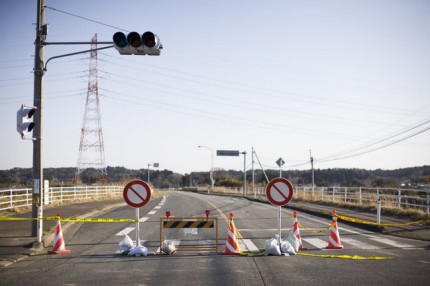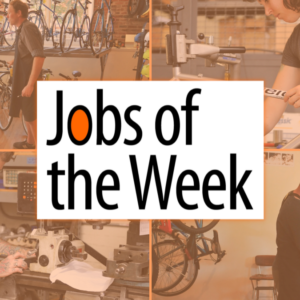
(Photo: Motoya Nakamura/The Oregonian)
“A community that has the human and physical infrastructure to support transportation methods other than cars would almost by definition be more resilient than one that is reliant on cars.”
— Joe Partridge, Deputy for Planning and Preparedness for Multnomah County
When disaster struck Japan two months ago, the power of the earthquake and the devastating tsunami that followed crumpled many roads in the affected areas. As people tried to resume their lives, one bright spot (at least to observers from afar) was that the humble bicycle emerged as a vital tool to help people and goods move around on roads where cars were useless.
Following the disaster, bicycle sales boomed, and even the New York Times noted the “burst of enthusiasm for bicycling.”
Yesterday we read in The Oregonian, that experts think a similar disaster could befall the Pacific Northwest.
When disaster strikes here in Portland; what role will bicycles play? After all, we have not only the largest percentage of regular bike riders of any big city in America, we’re deep when it comes to cyclocross talent (for those hard to pass roads), and we’ve got a flourishing cargo bike scene.
That article in The O paints a dire picture. One consultant is quoted as saying, “The majority of our transportation system will be crippled.” Another adds that, “Oregonians could reduce impacts by bolting houses to foundations, assembling emergency kits and buying non-sparking wrenches for turning off natural gas.”
Should we add a tuned-up bicycle to those emergency kits?
Looking for some perspective on this, I asked Joe Partridge, Multnomah County’s Deputy for Planning and Preparedness (who also happens to be a bike racer and all-around bike fan).
Does our transportation network figure into the county’s disaster plans?
There are many different kinds of disasters and they effect the transportation network in different ways. Clearing debris from roadways is critical in many disasters; it is necessary for both first-responders and residents to get where they need to go and to deliver disaster relief supplies. Bridges are also an important part of the transportation network in our area. Many people live and work on opposite sides of the river; damage to bridges would complicate relief and response operations.

cyclocross skills to use if necessary.
When I mentioned the potential role of bicycles in an email recently, you referred to them as “alternative evacuators.” What did you mean by that?
Hmmm, I think I might have coined that term on the fly. I was thinking about people that would choose to evacuate by a method other than automobile. Much of the community evacuation guidance I have seen from the federal government assumes people prefer to evacuate by car. You can see [from that FEMA link] that the assumption is that if you can’t drive, you have to rely on government (or family) to help you.
We know that there are many people in and around Portland that lead a car-free lifestyle not out of need but instead because it is their desired mode of travel. It makes sense to me that some of these people would choose to evacuate by bicycle in the event of a disaster.
Do you think Portland being such a bike-centric city will help it deal with major disaster that compromises the road network?
It’s hard to say. The type of disaster prompting the evacuation and the time of year would have a significant effect on the number of people that would choose to evacuate by bike. I think for small scale and short duration evacuations, the use of a bicycle (or walking!) could be a great option. For a large-scale disaster during inclement weather requiring a long-distance evacuation, I think fewer people would be willing or able to evacuate by bike.
In your professional opinion, do you think a city where bikes are common will be more resilient in the face of a disaster that compromises transportation networks?
Yes! A community that has the human and physical infrastructure to support transportation methods other than cars would almost by definition be more resilient than one that is reliant on cars. The ability to move people and goods without the use of fossil fuel (which could be in limited supply during and after a disaster) would increase the resiliency of a community.
So there you have it folks. If you haven’t already, make sure bicycles are part of your emergency preparedness kit.
— Further reading: The San Francisco Chronicle’s bike blog published a story about bikes and disasters today too!




Thanks for reading.
BikePortland has served this community with independent community journalism since 2005. We rely on subscriptions from readers like you to survive. Your financial support is vital in keeping this valuable resource alive and well.
Please subscribe today to strengthen and expand our work.
there’s an ‘evacuate by bicycle’ facebook group, you know: https://www.facebook.com/home.php?sk=group_38105764793¬if_t=group_r2j
Great article. There can be little doubt that many of Portland’s sustainable practices, from bikes to rain barrels, will serve to make our community more resilient when we are faced with serious challenges (like disasters). The best part; unlike two boxes of supplies in your garage, your bike, garden, rain barrel and solor panels all make the community stronger if there is no big earthquake or shock to the City!
Also, inflatable watercraft, for when the bridges fall into the Willamette.
but there will be downed power lines as well, making the waterway “impassable” (according to the Oregonian) by boat. The horror!
That’s silly. A live power line falling into a small body of water could cause a problem. Even lots of lines down in the Willamette would do nothing.
I am merely referencing what I read in the Oregonian. Also, I don’t believe many people would define the Willamette a “small body of water”. Finally, who’s to say what exactly will be floating in the Willamette (and where it will be floating) when a major earthquake happens that may also cause severe landslides in the area? Needless to say, operating a boat in these circumstances would not be the same as on a nice sunny day like today. Nor for that matter would riding one’s bike. Cyclocross skills a must!
I seem to have misread the “small body of water” comment; excuse my response to that.
I wonder if Tri-met has a contingency plan for installing cow catchers to plow abandoned vehicles off the tracks in the event of a zombie apocalypse?
Jonathan,
Thanks for this (especially the cyclocross suggestion). Every time I stay at the coast I wonder, ‘will this be the time I have to use my bike to save my life’? For people on the coast, I’ve heard that the Tsunami evacuation plan stipulates that people walk, not drive, to higher ground. I think a bicycle, with appropriate gearing, would make an excellent choice to escape high waters. Add some nobby tires, a good Ortlieb messenger bag stuffed FULL of cliff-bars and a couple of jugs of water–hopefully good to go. I’m guessing that would be the fastest average speed I ever attain; the adrenaline rush would be amazing!
I still think that we are potentially ‘worse-off’ than communities in Japan because there’s no all-encompassing, everybody know’s it, “easy” to implement Earthquake preparedness plan. Sure, there are plenty of public announcements to the tone, “be prepared, have an emergency kit”, but in Japan, it’s a bit more like, “populace: you are under threat from x, y, z. You will receive instruction in school and on tv FREQUENTLY about these threats. It’s hard to think you won’t know what to do because THIS is an ordered society”. So at that level, I’m forced to believe that there’s a societal/cultural divide that makes disaster plans in Japan slightly more “successful”–at least better known–than in good, old Portland, OR. Plus, would we really want the government telling us what to do continually and how to react to threats??? Probably not, unless it involved threat-level ORANGE and heightened risk of terrorism and a reason to buy more handguns… but that’s my thinking on the matter.
Bikes in disaster areas? It makes the imagination go wild!
Most likely it’ll be an earthquake, and many of the roads will be not passable by car, because the landscape will be disheveled. You can’t portage a car, but you can a bike.
I know they filmed part of the “The Road” (post-apocalyptic walk-a-thon) in SE near Mt. Tabor. Portland, always typecast as a disaster zone…
As long as my garage doesn’t collapse on my bikes, I should be good to go..
While the remote possibility of the big one gets all the press, but the little one happens all the time. Washed out roads and culverts, closed bridges and landslides. A few years ago, South Clackamas River Road was closed for a landslide. Local bikers and walkers loved the car free road. Bikers loved it when the old Farmington Road bridge was closed before replacement. The way things are going, the Sellwood may be a great bike bike bridge soon.
Then there is the nearly annual snow disaster. Being able to walk and ride a bike is always a good “alternative”.
We have ham radio and bicycles, good to go.
Me too. Just have to figure out about the dog.
A bicycle will be a great tool for individuals getting around after a disaster when the roads are a mess. Not so useful for evacuations, I would think. First responders and emergency crews should be equipped with access to enduro style motorcycles that can get them where they need to be when roads are damaged or gridlocked.
Evacuate to where because of what? In japan, the hordes won’t rob your house blind if you evacuate. That’s not true here, as happened during hurricane katrina. I’ll sit and wait it out, thankyouverymuch. Also, guns. You city folk have to be scared of godzilla, or twilight, or whatever the monster of the day is, since they’re attracted to concentrated light and light to boogey.
I would hope that Portland is a bit more civilized in a disaster than New Orleans. Was there mass looting in New York on 9/11?
No, but there was no mass evacuation either. There was no transportation for workers to get home since the subways were closed. If given a chance to riot and not Japan, people will riot. It’s just too fun. Look at Los Angeles during rodney king or seattle during wto.
Agreed. What makes Portlanders more civilized than those living in New Orleans?
When people are trying to survive and civilization as they know it has collapsed, they do stupid things.
True, there wasn’t looting in the traditional sense post 9-11, but I do recall gas stations raising their prices 5x over night – plus rationing.
How many people have mass amounts of money in their homes in order to pay for food and fuel when debit/credit doesn’t work?
How far is someone willing to go to feed their family? I’d go pretty far.
Apocowlypse, shurely
The new light rail bridge (Caruthers) which will be designed for light rail, bus and bikes/peds (no cars) will be the first Willamette River Bridge built to modern seismic standards. Bikers working on the west side should be able to get home to SE if they can maneuver around all those pedestrians using the only extant Willamette River bridge.
We recently completed the Transportation System Plan for Seaside, in which we included tsunami evacuation routes specifically for bikes and pedestrians. The routes include proposals for new bridges over the creek and river that run parallel to the coast. When the big one hits, better hope one of your bikes is close by, the car will be parked where ever the traffic bogs down.
fire bike
http://www.google.com/imgres?imgurl=http://www.myconfinedspace.com/wp-content/uploads/2009/10/fire-bike-500×375.jpg&imgrefurl=http://www.myconfinedspace.com/2009/10/29/fire-bike/&usg=__L3zDmNvpYgm8JnAI5Oa58uejdAw=&h=375&w=500&sz=43&hl=en&start=9&zoom=1&tbnid=xKGmVZgqdmGNvM:&tbnh=98&tbnw=130&ei=fb7OTcXNDIn6swOD2umrCw&prev=/search%3Fq%3Dfire%2Bbike%26um%3D1%26hl%3Den%26sa%3DN%26rlz%3D1T4TSNA_en___US356%26biw%3D1345%26bih%3D520%26tbm%3Disch&um=1&itbs=1
Bikes barely made a difference in Northridge Earthquake. I-10 went back up in a heartbeat.
Thanks for the great article, Joe and Jonathan! Next episode on social connectivity and emergency preparedness?